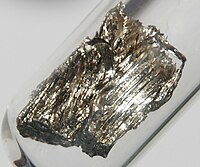
Photo from wikipedia
The present work deals with the investigation of solvent extraction of Sm(III) from chloride medium using di-(2-ethylhexyl)phosphoric acid (D2EHPA) and trihexyl tetradecyl phosphonium bis(2-ethylhexyl)phosphate ([P66614][D2EHP]) as extractants. In the extraction… Click to show full abstract
The present work deals with the investigation of solvent extraction of Sm(III) from chloride medium using di-(2-ethylhexyl)phosphoric acid (D2EHPA) and trihexyl tetradecyl phosphonium bis(2-ethylhexyl)phosphate ([P66614][D2EHP]) as extractants. In the extraction stage, the effect of contact time, aqueous phase pH, extractant concentration, NaCl concentration, temperature effect, stripping and O:A ratio variation are investigated to compare the extraction abilities of D2EHPA and the ionic liquid made from that. The complex formation ability and extraction mechanism of samarium with two extractants are explained by FTIR spectra and slope analysis method. Solvent extraction of samarium is better noticeable with D2EHPA than that of [P66614][D2EHP]. It is evident that with rise in pH of the aqueous medium, the extraction percentage of samarium is increased for both the extractants. Optimum extraction (100%) of Sm3+ is obtained with 0.1 mol/L D2EHPA and 0.1 mol/L [P66614][D2EHP], respectively. HNO3 is the best stripping agent for back-extraction of samarium from the loaded extractants. Separation studies are carried out in the presence of transition metal ions (mostly present in magnets) to know the efficiency of D2EHPA and ionic liquid [P66614][D2EHP]. The extraction studies with mixture of other rare earth metal ions similar to monazite composition follow the order as Gd(III) > Sm(III) > Nd(III) > Ce(III) > La(III) for both the extractants. Using 0.03 mol/L D2EHPA, complete separation of Gd and Sm from the rare earth mixtures is found at two stages with O:A ratio of unity.
Journal Title: Transactions of the Indian Institute of Metals
Year Published: 2020
Link to full text (if available)
Share on Social Media: Sign Up to like & get
recommendations!